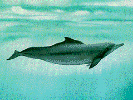
From October to December and February to May in the northwestern African country of Mauritania, Atlantic hump-backed dolphins take part in a cooperative effort to catch a fish called mullet. Their partners are not only bottlenose dolphins but also the villagers, who leave their homes to camp along the Bay d'Argun during mullet season. Entering the water on foot, the villagers dip hand nets into the water to catch passing fish.
Imitating the splash made by the jumping fish, the villagers hit the surface of the water with sticks. The noise and commotion attract the dolphins, which swim toward the shore, blocking the mullet's escape. As the mullet are driven into the fishermen's nets, both dolphins and fishermen harvest a bounty of fish.
The villagers are grateful to the dolphins, although those which strand or die accidentally are used for food or oil. the people of Mauritania and nearby Senegal, where the species is also found, need every food source they can find to survive.
Sousa teuszii
Size: 2 m, 100 kg
Calves at birth: Unknown
Teeth: 26 to 31 peglike teeth on each side of upper and lower jaws
Food: Fish (mullet) and crustaceans
Habitat: Coastal waters
Range: Off West Africa, from Mauritania south to Cameroon and
perhaps Angola
Status: Population unknown
